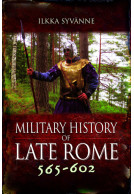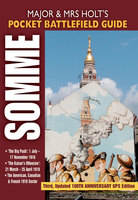The Military History of Late Rome 361-395 (ePub)
Imprint: Pen & Sword Military
File Size: 40.4 MB (.epub)
Pages: 293
Illustrations: 32
ISBN: 9781473872233
Published: 6th December 2018
This is the second volume in an ambitious series giving the reader a comprehensive narrative of late Roman military history from AD 284-641. Each volume (5 are planned) gives a detailed account of the changes in organization, equipment, strategy and tactics among both the Roman forces and her enemies in the relevant period, while also giving a detailed but accessible account of the campaigns and battles.
This volume covers the tumultuous period from the death of Constantius II in AD 361 to the death of Theodosius. Among the many campaigns covered, it therefore includes the Emperor Julian's fatal campaign against the Sassanian Persians and the disastrous defeat and death of Valens at Adrianople in 378. Such calamities illustrate the level of external threat Rome's armies faced on many fronts in this difficult period.
I confess, I haven’t developed a major interest in the late history of the Roman Empire, particularly the portion of the empire’s story when it had split in two.
John D. Burtt
Cursory reading found too many invasions going on and too many dudes crowning themselves emperor only to be usurped by someone else. However, a series is being published that might change my interest. Pen and Sword has teamed with Dr. Ilkka Syvänne, University of Tampere in Finland, to produce a seven volume Military History of Late Rome. Five volumes have been published so far, covering the period 284 AD to 518 AD. Book 6 takes the story out to 565 AD and is due in May 2021.
Syvänne starts each book with an overview of where the Roman Empire stood at the start of the period being covered; this includes administrative as well as the military situation. He then discusses details of the “enemies” Rome faced at this time. The first several books have far more information on the various threats from the Picts in the West, the Germanic tribes in the North, the Arabs in the South, and the various Persian empires in the east. Following those chapters, he delves into a narrative of the period covered by the particular book.
As you can probably imagine with a series of books extending over 300 years, trying to fit “what has come before” in each volume could have been extensive, so the author has simply given you a snapshot of where the book begins. So, you can end up with somewhat cryptic statements like this one from book four (425-457 AD) “The empire somehow managed to weather out the disasters caused by Honorius’s racist policies.” Begging of course the question, ‘what racist policies?” (hint: they’re in book #3 (395-425 AD.) If you are interested in a particular leader (say Constantine, or Justinian) knowing their dates will help you figure which book to get.
If you’re interested in the whole period, start from #1 and read on. Syvänne has provided lots of maps and diagrams to aid your reading. This is a colossal work.
There are a couple caveats to my recommendation. First, the text is very dense. This is not light reading at all. The books have a lot of information in them and you can easily go into overload if you try to read and assimilate too fast. Taking it more slowly will reward you.
The second caveat is more of a warning. I have read other reviews of the series that call into question some of Dr Syvänne’s conclusions and assumptions; some of the questions simply point to not having enough detailed footnotes to track or confirm a source. As a non-ancient Roman expert, I really cannot comment on the questions. However, I found I enjoyed reading the narratives without the usual “this source says this” and “that source says that” and liked the author’s attempts to tell you when he disagrees with someone else’s conclusions. He has provided a good list of sources and endnotes to aid those who want to delve deeper into particular periods of this history.
But delving into the details is what afficianado’s of the period will and should do for themselves. For readers interested in a very good overview of 300+ years of Roman history, this one is worth a look.
"An outstanding work… [the series] gives us a very good picture of the long process that has come to be known as the “Fall of Rome”. This is an invaluable read for anyone with an interest in Late Antiquity.”
The NYMAS Review
This is not "another book on the fall of the Roman Empire": It is a broad perspective, very complete, fresh and particularly critical of the realities of the Roman Empire and its world between 361-395 A.D., where while political-military history focuses discourse, circumstances socio-economics end up being approached with great precision, as an inescapable analysis
Desperta Ferro – reviewed by David Soria Molina
As featured in
Medieval Sword School
As featured 'on the shelf' by Neil Smith
Wargames Illustrated, June 2017
About Dr Ilkka Syvanne
DR ILKKA SYVÄNNE* gained his doctorate in history in 2004 from the University of Tampere in his native Finland. Since then he has written extensively about ancient and medieval warfare and his publications include: The Age of Hippotoxotai, Art of War in Roman Military Revival and Disaster 491-636 (Tampere UP 2004), the multi-volume Military History of Late Rome published by Pen & Sword and the critically acclaimed Caracalla: A Military Biography also published by Pen & Sword. He is the co-author with Professor Katarzyna Maksymiuk of The Military History of Third Century Iran (Siedlce UP, 2018) and The Military History of Fifth Century Iran (Siedlce UP, 2019). He was Vice Chairman of the Finnish Society for Byzantine Studies from 2007 until 2016. He was appointed as an Affiliated Professor of the University of Haifa in 2016. He lives in Kangasala, Finland.




















